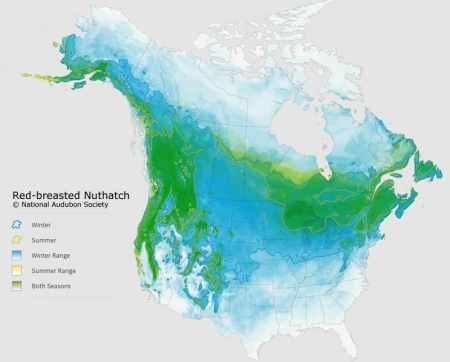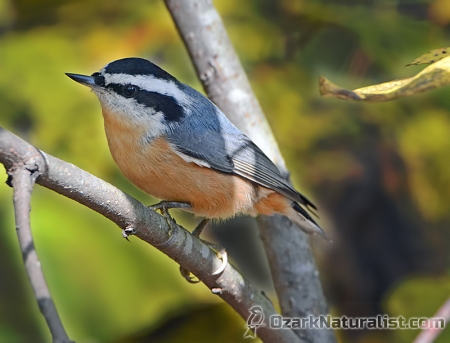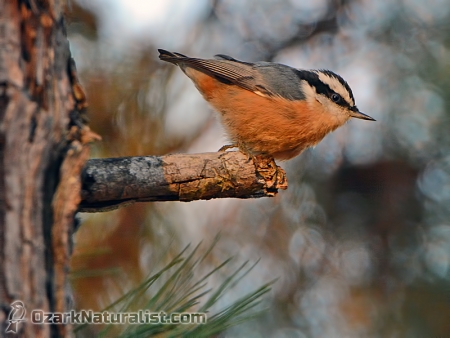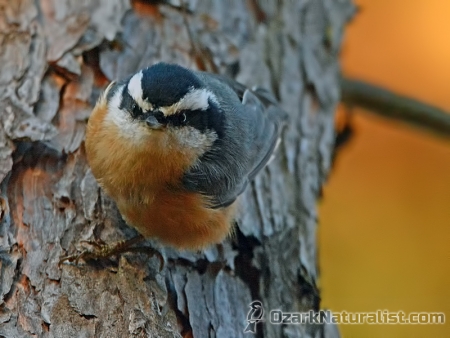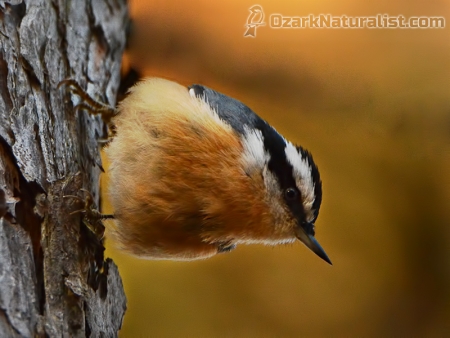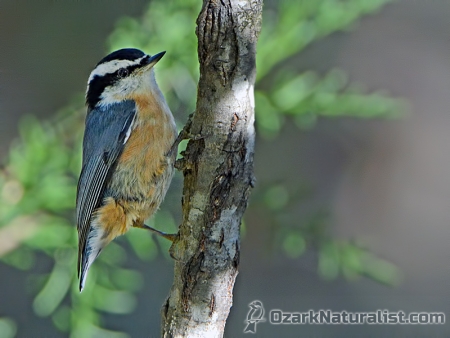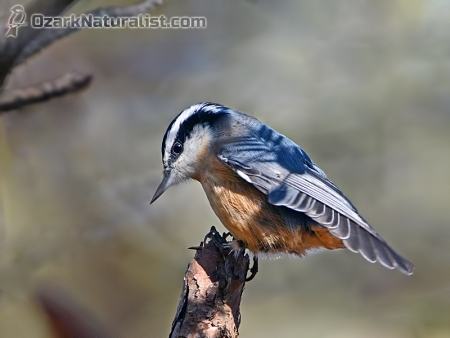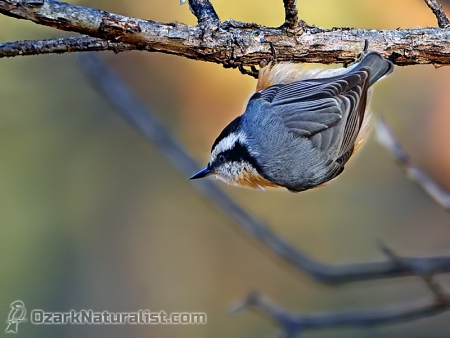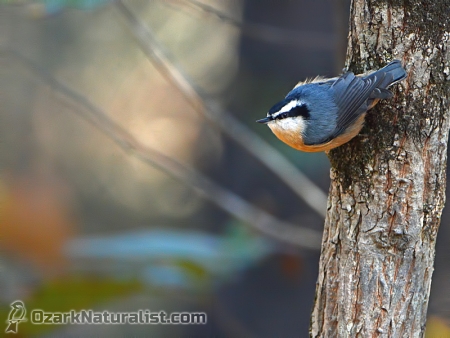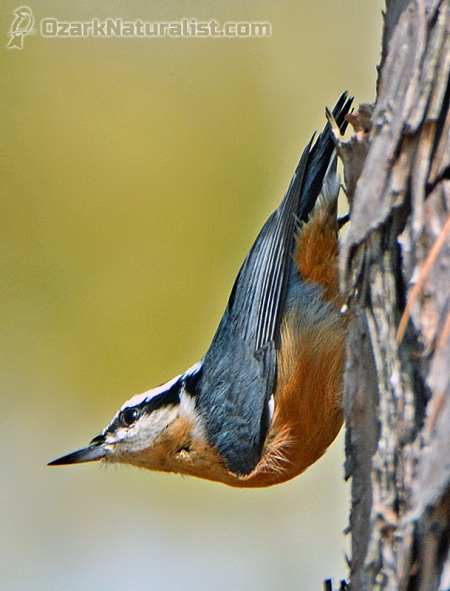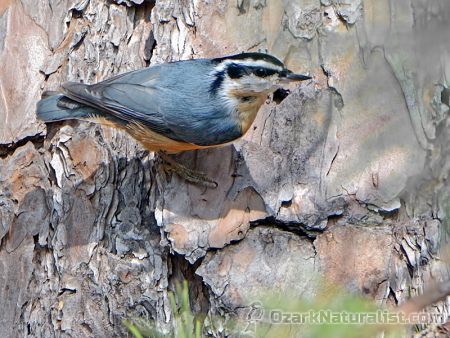Winter range varies tremendously from year to year, especially in east. Big southward invasions occur in fall of some years, perhaps mainly when cone crops are very poor in the northern forest. In years with good food supply, may remain all winter on nesting territory.
That quote and visual representation (some sophisticated folks might call that a map) come straight from the National Audubon Society’s Online Guide to North American Birds Red-breasted Nuthatch page. Based on what they tell us, I’d say something went wrong up north, whether the cone crop failed or something else entirely, because the little buggers have apparently marshaled their forces and invaded in large numbers.
The first signs appeared back in September. Folks on the MOBIRDS Listserve began reporting Red-breasted Nuthatch (RBNH) sightings along the eastern part of the state, then further west in the Columbia-Jefferson City area. Finally, someone reported birds at Eagle Point Recreation Area on Lake Wappapello, only about 50 miles east of here and that prodded me into action. I’d been thinking of going out to see if I could find a bird or two and now that they had been reported so close, I knew I to try.
Originally, I was thinking of driving to Eagle Point since I knew they were there, or had been a day or two before. But it’s an hour away and, duh, we have plenty of appropriate habitat for nuthatches locally. So I ended up going to work instead. Not actually to work, but where I work, which has a stand of old growth Shortleaf Pine right outside the back door and seemed like an easy place to start looking. It was windier than I would have liked and at first, I was having no luck. But after 15 minutes or so, I ran into one of those mixed flocks of chickadees, titmice and kinglets that roam the woods in the fall and winter and among them I heard the yank yank yank of a nuthatch. It sounded not quite right for our common White-breasted Nuthatch, so I started tracking the call.
Sure enough, it was a Red-breasted and while I got a couple of photos before losing track of him, the light wasn’t very good and I wasn’t satisfied with them. So I headed for my fall back location at the Park’s sewage lagoon at Big Spring. The lagoon sits right in the middle of a thick stand of pine planted by the CCCs in the 1930s. It’s several times larger than the stand at Park Headquarters and significantly thicker to boot.
I parked outside the chain link fence that surrounds the treatment ponds and walked back up the road into the pines. Five minutes later I head the yank yank yank call again and began working my way closer. This bird was a more compliant—almost tame in fact—and I ended up with a much better photo.
That was on Sunday and the following Friday found me at Peck Ranch chasing elk (that’s another post). The elk moved into the timber shortly after daylight and once they were gone, I started looking for nuthatches again. Peck Ranch is a large block of land, approximately 22,000 acres with about half of that inside the core refuge area. It also happens to host a lot of potential RBNH habitat.
I only stopped at a few locations, the first being at the junction of Roads 10 & 13. The roads meet at a “T” and on the southeast side is a thin stand of pine, recently cut over. I immediately heard chickadees and kinglets and it wasn’t long before I found a RBNH.
Another very tame bird, he came in close to give me the once over in return.
I heard a second bird calling, but never got close enough to see it. Back in the truck, I headed on down 13 and stopped at a larger, thicker pine stand, just before the intersection with Road 11. This is a sweet stand of pine, but I struck out on RBNHs, though I did find Carolina Chickadees, Tufted Titmice, Blue Jays, a Pine Warbler and a Brown Creeper. I got a couple of shots of the Pine Warbler, but the Creeper stayed high in a pine and I couldn’t get much of a shot. I have quite a few Pine Warbler images, but almost no Creepers, so this was disappointing.
Following that stop, I left the refuge and headed back towards the house. But just before you leave the CA proper, I made one more stop at a parking lot abutting a dense copse of pines. The canopy was tight, so there wasn’t much light coming through and the undergrowth was thick and often sharp. But I found not one, but three, RBNHs.
I could have undoubtedly found more birds had I kept looking. But I’d gotten up at 4:30, been at the CA since well before daylight and I was getting hungry. And my stomach almost always wins, a statement that you wouldn’t argue with if you happened to see me.
The story isn’t quite finished though. This past Friday during my lunch break, I was sitting on my truck tailgate when I heard yank yank yank in the pines nearby. I already had my camera laying beside me, so when the RBNH came down the large pine 30′ in front of me, I was ready for him. This was very likely the same bird I found and photographed almost two weeks earlier, though I have no proof of that.
I like to find and document as many species as possible on my 17 acres of land and I put in some effort to locate an RBHN to add to the list, but didn’t have any luck. Then this past Saturday, as Dayna and I were leaving for Poplar Bluff, I heard the now familiar yank yank yank emanating from the woods behind the pond. I heard another bird (or perhaps the same one) on Sunday when I had the dogs out to do their business. I did look for this one after I had the dogs back in the house, but he had moved on by the time I returned.
Anyway, there are an inordinate number of Red-breasted Nuthatches in the Ozarks this fall and I’m guessing they’ll stay all winter. They’re easy to attract to bird feeders if you don’t feel like pursuing them in the wild. Just put out suet, sunflower seeds, peanut butter and, especially, nuts and if there’s one nearby, he’ll probably stop by for a meal.
